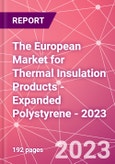This report examines the European market for thermal insulation products and their different uses in building and in industry, as well as identifying key trends impacting the industry.
Thermal Insulation Materials Overview
Various factors affect the type and amount of thermal insulation required. These can include:
- Climate
- Durability
- Ease of installation and replacement at end of life
- Cost effectiveness
- Toxicity
- Flammability
- Environmental impact and sustainability
- Energy efficiency
Expanded Polystyrene (EPS)
EPS is a relatively low-cost material with excellent insulating properties. Its lightweight nature means that it adds little to structural weight, yet still offers high dimensional stability. The foam is closed cell and therefore resistant to water penetration, although it is not a water vapour barrier. EPS does not deteriorate, it is non-toxic, non-irritant, and does not contain blowing agents. EPS has a low thermal conductivity and therefore good thermal insulation properties. Its chief disadvantages are its susceptibility to physical damage, its flammability characteristics, and its low resistance to chemical attack, including substances like dilute acids, alkalis, methanol and i-propanol. EPS foam can also be used at extremely low temperatures without any time restriction.
EPS is typically encountered in three forms:
(i) As rigid lightweight slab or board for use in wall, floor and roof insulation and cavity fill
(ii) EPS sheet bonded to plaster for use in dry lining and roofing extensions
(iii) Loose fill bead for use in cavity fill and loft insulation
For the first time, the EPS market is segmented into grey EPS and white EPS
End-Use Sector Definitions
For the purpose of this study, the end-use sectors have been split into building and industrial.
Building
This sector includes commercial and domestic building, cold storage and agricultural storage. The building sector generally takes up to 90% of volume (m3) of the insulation market.
Domestic building is split into flooring, roofing and wall insulation. Thermal insulation for domestic pipe work and air conditioning applications are not included in the building market figures. It was found that some respondents could not separate heating and ventilation figures for domestic and commercial buildings from the usage in industrial buildings and process plant. There is therefore some overlap in the definitions used by the trade. This approach of combining both sectors into a unique pipe lagging market eliminates double counting.
Industrial
This sector consists of the following:
- Pipe lagging: This includes the thermal lagging of industrial pipe work, ducts and plant. Where domestic pipe work has been identified this is also included, as well as insulation of district heating pipes.
- Process Plant and Machinery: This section includes all applications in process plant (except the lagging of pipe work and ducts) and in ancillary equipment. A special feature of this end-use sector is the requirement for very high temperature insulation in furnaces, ovens, etc.
- Domestic and Commercial Appliances: This sector covers refrigerators, freezers, cookers and storage and other heaters. Market figures exempt other minor uses, such as irons and commercial presses.
- Transport: Road, rail, and sea transport is considered. Applications include the production of refrigerated vehicles and boatbuilding.
Countries covered: Austria, Baltics (Estonia, Latvia and Lithuania), Belgium, Bulgaria, Croatia, Czech Republic, Denmark, Finland, France, Germany, Hungary, Ireland, Italy, Netherlands, Norway, Poland, Portugal, Romania, Russia, Slovakia, Slovenia, Spain, Sweden, Switzerland, Turkey, UK
Table of Contents
Companies Mentioned (Partial List)
A selection of companies mentioned in this report includes, but is not limited to:
- Armacell
- BASF
- Bauder
- Dow Chemical
- DuPont
- HIRSCH Porozell
- Kingspan
- Knauf Insulation
- Owens Corning
- Ravago
- Recticel
- Rockwool
- Saint-Gobain Isover
- UNILIN
- URSA
Methodology
Information provided in these reports are based on existing in-house data and an extensive programme of interviews with leading product manufacturers, trade associations, distributors and raw materials producers involved with the specific market researched. These interviews are conducted within the 3-6 months leading up to the publication of the study, with the duration of the research programme and the number of interviews completed depending on the scope of the study. The analyst publishes both regional and global reports, and in most cases, the interviews are conducted in the native language of the individual respondents.
In addition, published data and statistics are also reviewed in order to produce as accurate figures as possible for size of markets studied. Market forecasts are based upon industry and economic forecasts as well as upon other relevant commercial and technical issues likely to affect individual market sectors and products, as well as the interviews conducted for the study.

LOADING...








